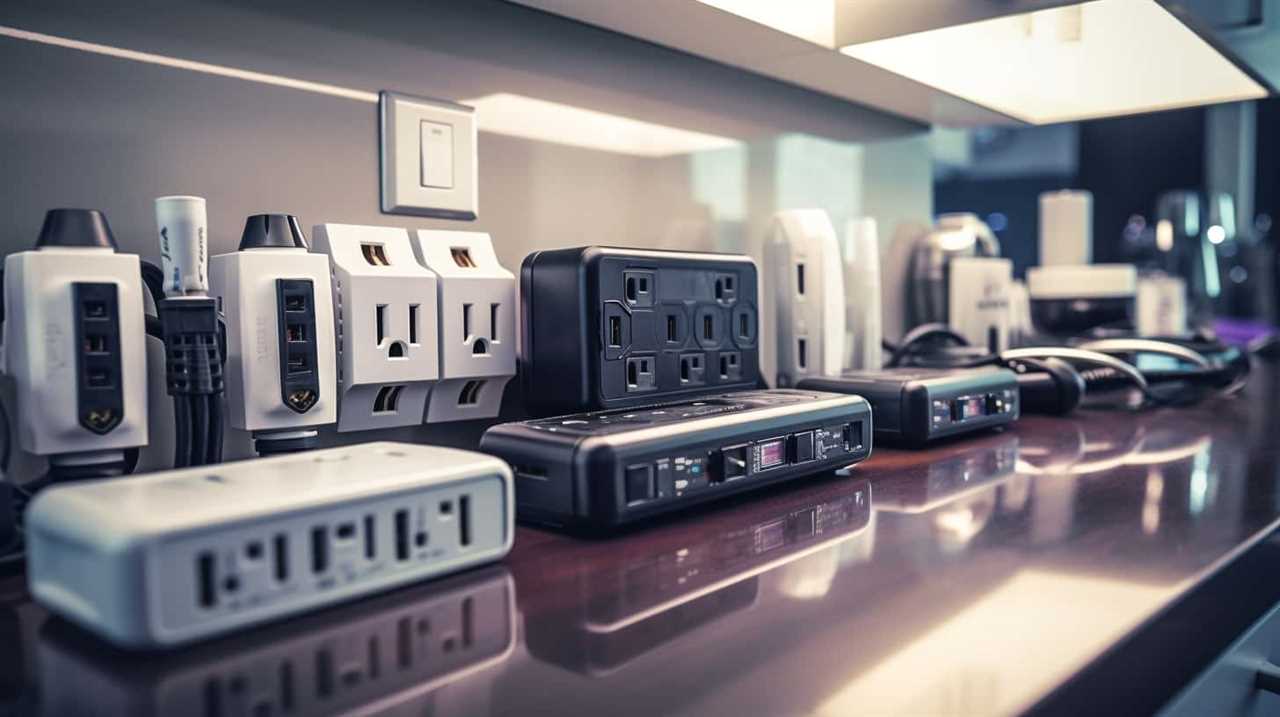When shopping for appliances, many consumers question whether they can skip the intermediary and buy directly from the manufacturer. This inquiry stems from a desire for the top prices, quality, and customer support.
In this article, we will explore the possibility of buying appliances directly from manufacturers, weighing the pros and cons, and shedding light on common misconceptions. By understanding the benefits and considerations of this direct purchasing approach, readers will be equipped to make informed decisions when shopping for appliances.
We will also provide alternatives to buying directly from manufacturers, ensuring that readers have a comprehensive understanding of their options.
So, let us delve into the realm of purchasing appliances directly from manufacturers and unravel the truths behind this practice.

Key Takeaways
- Buying appliances directly from the manufacturer can potentially lead to cost savings by eliminating middlemen.
- Direct sales offer access to a wider range of products, providing more options for consumers.
- Purchasing directly from the manufacturer allows for better customer service and support without intermediaries.
- Researching and comparing prices across manufacturers is crucial to ensure the best deal, taking into consideration factors such as warranty and product quality.
Pros of Buying Direct From Manufacturer
What are the advantages of purchasing appliances directly from the manufacturer?
When it comes to buying appliances, there are clear benefits of direct buying and taking advantage of manufacturer direct sales.
One major advantage is the potential cost savings. By eliminating middlemen, manufacturers can offer their products at lower prices. This is because they don’t have to factor in the additional costs associated with distribution and retail markup.
Additionally, buying directly from the manufacturer allows for a more personalized experience. Customers can often access a wider range of products, receive expert advice, and enjoy better customer service.

Another advantage is the assurance of authenticity and quality. When purchasing directly from the manufacturer, customers can be confident that they are getting genuine products that meet the highest standards.
Cons of Buying Direct From Manufacturer
There are certain drawbacks to purchasing appliances directly from the manufacturer.
While there are advantages such as lower prices and the ability to customize your order, there are also some cons to consider.
One of the main drawbacks is that manufacturers may not offer the same level of customer service as retailers. If you encounter any issues or have questions about the product, it may be more difficult to get assistance directly from the manufacturer.

Additionally, buying direct from the manufacturer may limit your options in terms of product selection. Retailers often carry a wider range of brands and models, giving you more choices to suit your specific needs.
Benefits of Cutting Out the Middleman
By cutting out the middleman, consumers can enjoy several benefits when buying appliances directly from manufacturers.
One of the main advantages of bypassing retailers is the potential cost savings. When purchasing directly from the manufacturer, consumers can avoid the additional markups that retailers often add to the price. This can result in significant savings, allowing consumers to get more value for their money.
In addition, buying directly from the manufacturer can also provide greater transparency and control over the purchasing process. Consumers can have direct access to product information, specifications, and warranties, ensuring that they make an informed decision.

Furthermore, dealing directly with the manufacturer can also lead to better customer service and support, as there are no intermediaries involved.
Overall, cutting out the middleman offers numerous benefits, making direct manufacturer purchases an attractive option for consumers who seek quality, affordability, and convenience.
Now, let’s explore how to find manufacturers that sell directly.
How to Find Manufacturers That Sell Directly
To locate manufacturers that sell directly, it is essential to utilize reputable industry directories and online platforms. These resources provide a comprehensive list of manufacturers and their contact information, making it easier for consumers to connect directly with them. Here are some effective ways to find manufacturers that sell directly:

- Utilize industry directories: Reputable industry directories such as ThomasNet, Alibaba, and Global Sources are valuable resources for finding manufacturers. These directories categorize manufacturers by industry, location, and product type, allowing users to search for specific manufacturers easily.
- Attend trade shows: Trade shows offer an excellent opportunity to meet manufacturers face-to-face and learn about their products. Many manufacturers use these events to showcase their offerings and connect with potential customers.
- Conduct online research: Conducting thorough online research can help identify manufacturers that sell directly. Using search engines and social media platforms to search for specific product types or industries can yield valuable results.
- Join professional associations: Professional associations related to the industry of interest often have directories or resources that list manufacturers. Joining these associations can provide access to exclusive information and networking opportunities with manufacturers.
Finding manufacturers that sell directly offers several advantages. First, it eliminates intermediaries, reducing costs and potentially allowing for lower prices on appliances. Second, direct sales provide an opportunity to communicate directly with manufacturers, enabling consumers to inquire about product specifications, customization options, and warranties. Additionally, purchasing directly from manufacturers may provide access to exclusive deals or limited-edition products.
Top Appliance Manufacturers That Offer Direct Sales
When it comes to buying appliances directly from the manufacturers, there are several top companies that offer this option. Some notable manufacturers that provide direct sales include Samsung, LG, Whirlpool, and GE Appliances.
Buying appliances directly from these manufacturers can have several benefits. Firstly, it gives you access to a wider range of products. Manufacturers often have a larger inventory available for direct purchase, including exclusive models or variations that may not be easily found in retail stores.
Secondly, buying directly from the manufacturer can potentially result in discounts or promotions. Manufacturers may offer special deals or lower prices for customers who purchase directly from them. This can be especially beneficial if you’re looking to buy multiple appliances or if you’re on a tight budget.

Lastly, purchasing appliances directly from the manufacturer gives you access to direct customer support. If you have any questions or issues with your appliance, you can contact the manufacturer’s customer support team directly for assistance. This can be more convenient and efficient compared to dealing with a third-party retailer.
Manufacturer Direct Sales
Which top appliance manufacturers offer direct sales to customers?
Some of the top appliance manufacturers that offer direct sales to customers include:
- Samsung: Samsung offers a direct sales option on their website, allowing customers to purchase appliances directly from the manufacturer. This eliminates the need for a middleman and can potentially result in cost savings.
- Whirlpool: Whirlpool also provides a direct sales channel on their website, giving customers the opportunity to buy appliances directly from the manufacturer. This can provide a seamless shopping experience and direct access to customer support.
- LG: LG offers direct sales through their website, enabling customers to purchase appliances directly from the manufacturer. This allows for greater convenience and access to exclusive deals or promotions.
- GE Appliances: GE Appliances provides a direct sales option on their website, allowing customers to buy appliances directly from the manufacturer. This can offer the advantage of purchasing directly from the source, ensuring authenticity and quality.
These manufacturers offer the convenience of purchasing appliances directly from the source, eliminating the need for intermediaries and potentially providing cost savings.

To find manufacturers that offer direct sales, customers can visit the official websites of appliance manufacturers or search for authorized retailers that offer direct sales options.
Benefits of Buying Direct
Appliance manufacturers that offer direct sales provide customers with the convenience of purchasing appliances directly from the source, frequently resulting in cost savings and access to exclusive deals and promotions.
Buying appliances directly from the manufacturer eliminates the need for middlemen, such as retailers, which can often lead to reduced prices. By cutting out the middlemen, manufacturers can offer their products at competitive prices, passing on the savings to customers.
Additionally, direct sales allow manufacturers to have more control over their pricing strategies, which can result in exclusive pricing benefits for customers. These exclusive deals and promotions may include discounts, special bundles, or extended warranties.

Tips for Negotiating Pricing With Manufacturers
When negotiating pricing with manufacturers, there are several important steps to follow.
Firstly, it is crucial to begin by researching competitor pricing to establish a benchmark. This will give you leverage when discussing pricing with the manufacturer.
Secondly, it is beneficial to highlight the long-term benefits of the product. By emphasizing the value that the product will bring to the manufacturer and their customers, you can help justify a lower price.
Lastly, it is crucial to approach negotiations with confidence. However, it is also important to be flexible. Finding a mutually beneficial agreement is key.

Research Competitor Pricing
One effective strategy for negotiating pricing with manufacturers is to thoroughly research competitor pricing. By understanding the prices that other manufacturers are offering for similar products, you can leverage this information when negotiating with the manufacturer of your choice.
Here are some tips to help you research competitor pricing:
- Utilize online search engines to compare prices across different manufacturers.
- Visit retail websites and physical stores to gather information on competitor pricing.
- Take note of any discounts, promotions, or special offers that may influence pricing.
- Consider factors such as warranty, customer service, and product quality when comparing prices.
Thoroughly researching competitor pricing allows you to have a better understanding of the market and empowers you to negotiate better deals with manufacturers. By knowing the prices offered by competitors, you can highlight the advantages of purchasing directly from the manufacturer and potentially secure a more favorable pricing arrangement.
Now, let’s move on to the next section and highlight the long-term benefits of buying appliances directly from manufacturers.

Highlight Long-Term Benefits
To effectively negotiate pricing with manufacturers, it is crucial to emphasize the long-term benefits of purchasing directly from the manufacturer. By highlighting the advantages of buying appliances directly, customers can better understand the value they are receiving and make informed decisions.
One of the major benefits is cost savings. When buying directly from the manufacturer, customers can often avoid extra costs associated with middlemen, such as retailers or distributors. Additionally, manufacturers may offer special discounts or promotions for direct purchases.
Another advantage is better customer support. Direct communication with the manufacturer allows for quicker resolutions to any issues or concerns.
However, there are also disadvantages to consider. Buying directly from the manufacturer may limit the variety of brands and models available, as manufacturers typically focus on their own products. Furthermore, customers may miss out on the personalized service and expertise offered by retailers.

Be Confident but Flexible
A key approach to negotiating pricing with manufacturers is to adopt a confident yet flexible stance. Being confident allows you to assert your needs and negotiate effectively, while being flexible enables you to adapt to the manufacturer’s terms and find common ground. Here are some benefits of being flexible in negotiations:
- Increased chances of reaching a mutually beneficial agreement
- Ability to explore alternative options and find creative solutions
- Building a positive relationship with the manufacturer for future collaborations
- Maintaining a reputation as a fair and reasonable negotiator
However, there are challenges to being confident in negotiations:
- Balancing assertiveness with the need to compromise
- Managing expectations and finding a middle ground that satisfies both parties
- Overcoming resistance or pushback from the manufacturer
- Avoiding unnecessary concessions that may not be in your best interest
Warranty Considerations When Buying Direct
The manufacturer’s warranty should be carefully considered when purchasing appliances directly from the manufacturer. Warranty coverage is an essential aspect to look into as it determines the level of protection and support you will receive in case of any defects or malfunctions.
When buying appliances directly from the manufacturer, it is crucial to understand the warranty terms and conditions, including the duration of coverage and what is included or excluded. Additionally, it is important to explore the customer support options available. This could include access to technical support, repair services, or replacement options.

Understanding the warranty coverage and customer support options provided by the manufacturer can help you make an informed decision and ensure that you are well-supported throughout the lifespan of your appliance purchase.
Now, let’s delve into the common misconceptions about buying direct.
Common Misconceptions About Buying Direct
One common misconception about buying appliances directly from the manufacturer is that it limits your options for customer support and repair services. However, this is not entirely true. In fact, there are several advantages of purchasing appliances directly from the manufacturer, including:
- Access to expert customer support: Buying directly from the manufacturer ensures that you have direct access to their knowledgeable customer support team who can assist you with any queries or issues you may have.
- Manufacturer’s warranty: When you buy appliances directly from the manufacturer, you often get the benefit of a comprehensive warranty that covers repairs or replacements.
- Authenticity and quality assurance: Purchasing directly from the manufacturer guarantees that you are getting authentic, high-quality appliances that meet the manufacturer’s standards.
- Direct communication: Buying appliances directly from the manufacturer allows you to communicate directly with them, enabling a smoother and more personalized shopping experience.
Contrary to popular belief, buying appliances directly from the manufacturer offers numerous advantages. However, there are alternatives to consider, which will be discussed in the subsequent section.

Alternatives to Buying Direct From the Manufacturer
When considering alternatives to buying appliances directly from the manufacturer, it is important to understand the concept of retailer markups. Retailers often add a markup to the original price set by the manufacturer, so exploring different retailers and comparing prices can help you find a better deal.
Another option is to explore online marketplaces, where you can find a wide range of appliances from various sellers.
Additionally, some manufacturers have factory outlet stores where you can find discounted prices on appliances that may have minor cosmetic imperfections but are otherwise in perfect working condition.
Retailer Markups Explained
Purchasing appliances directly from the manufacturer provides an opportunity to bypass the retailer markups and explore alternative options. Understanding the retail markup analysis is essential in making informed decisions. Here are some key points to consider:

- Retailer markups: Retailers often add a significant markup to the manufacturer’s price in order to cover their costs and make a profit. This can result in higher prices for consumers.
- Manufacturer direct sales: Buying appliances directly from the manufacturer eliminates the retailer’s markup, allowing consumers to potentially save money.
- Online retailers: Online platforms offer a wide range of appliances at competitive prices, often without the hefty markups seen in physical stores.
- Factory outlets: Some manufacturers have their own factory outlets where they sell appliances at discounted prices, making it another alternative to buying from retailers.
Online Marketplaces Comparison
Consumers have the option to explore alternative avenues of purchase, such as comparing online marketplaces, when considering alternatives to buying appliances directly from the manufacturer. Online marketplaces offer a convenient and efficient way to browse and compare a wide variety of appliances from different brands, all in one place. This allows consumers to easily find the best deals and prices available. Additionally, online purchases often come with the advantage of doorstep delivery, saving consumers the hassle of transporting bulky appliances themselves. However, it is important to note that there are also advantages to buying from authorized resellers offline. These include the ability to physically examine the appliances before making a purchase, as well as the assurance of buying from a trusted and authorized source.
| Advantages of Online Marketplaces | Advantages of Buying from Authorized Resellers |
|---|---|
| Wide variety of brands and options | Ability to physically examine appliances |
| Convenient and efficient browsing | Assurance of buying from authorized source |
| Best deals and prices available | Expert advice and customer support |
Factory Outlet Store Options
Factory outlet stores provide an alternative option for purchasing appliances directly from the manufacturer. These stores offer a variety of benefits, including factory outlet discounts and direct from factory pricing. Here are four reasons why factory outlet stores are worth considering:
- Lower Prices: Factory outlet stores often offer discounted prices compared to traditional retail stores. By purchasing directly from the manufacturer, customers can save money on their appliance purchases.
- Wide Selection: Factory outlet stores usually have a wide range of products available, including the latest models and a variety of brands. This allows customers to choose from a diverse selection of appliances.
- Quality Assurance: Since factory outlet stores sell appliances directly from the manufacturer, customers can have confidence in the quality of the products they purchase.
- Exclusive Deals: Factory outlet stores may offer exclusive deals and promotions that are not available elsewhere. This gives customers the opportunity to find discounted appliances and save even more money.
Final Thoughts on Purchasing Appliances Directly
When considering the option of buying appliances directly from the manufacturer, it is important to weigh the potential benefits and drawbacks of this direct purchasing method.
One potential benefit is the opportunity to negotiate the price directly with the manufacturer. By bypassing retailers, consumers may have a better chance of securing a lower price or additional discounts. However, it is important to note that negotiation strategies may vary depending on the manufacturer and their policies.

Another consideration is warranty coverage. Purchasing appliances directly from the manufacturer may provide more comprehensive warranty options, as they are more familiar with their own products and can offer better support. On the other hand, buying directly from the manufacturer may limit the ability to physically inspect the appliance before purchase, which can be a drawback.
Ultimately, consumers should carefully evaluate their own needs and preferences before deciding whether to buy appliances directly from the manufacturer.
Frequently Asked Questions
Are There Any Risks Involved in Buying Appliances Directly From the Manufacturer?
There are potential risks involved in buying appliances directly from the manufacturer, such as limited warranty coverage and potential difficulties with returns or repairs. However, there are also benefits, such as lower prices and access to exclusive models or features.
Can I Get a Better Deal by Purchasing Appliances From a Retailer Rather Than Directly From the Manufacturer?
When considering whether to purchase appliances from a retailer or directly from the manufacturer, it is important to weigh the potential for better deals against the advantages of manufacturer pricing and potential benefits of purchasing from a trusted retailer.

Are There Any Limitations or Restrictions on Warranties When Buying Appliances Directly From the Manufacturer?
When buying appliances directly from the manufacturer, it is important to consider the limitations on warranties. While there may be benefits such as lower prices and access to exclusive models, warranty coverage may be restricted compared to purchasing from a retailer.
How Can I Ensure That the Appliance I Purchase Directly From the Manufacturer Is of Good Quality?
To ensure the quality of an appliance purchased directly from the manufacturer, thorough research on the manufacturer’s reputation, customer reviews, and product testing should be conducted. Factors to consider include warranty coverage, customer support, and product specifications.
Are There Any Specific Advantages or Disadvantages to Buying Certain Types of Appliances Directly From the Manufacturer?
When buying appliances directly from the manufacturer, there are both advantages and disadvantages to consider. Advantages include potentially lower prices, access to exclusive models, and direct customer support. However, disadvantages may include limited warranty options and limited availability of certain appliances.
Conclusion
In conclusion, buying appliances directly from the manufacturer has its pros and cons.

While it allows you to enjoy benefits such as lower prices and better customer service, there are also drawbacks such as limited selection and potential warranty issues.
Cutting out the middleman can be beneficial, but it is important to research and find reputable manufacturers that offer direct sales.
One interesting statistic to consider is that according to a survey, 65% of consumers who purchased appliances directly from the manufacturer reported higher levels of satisfaction compared to those who bought from retailers.









